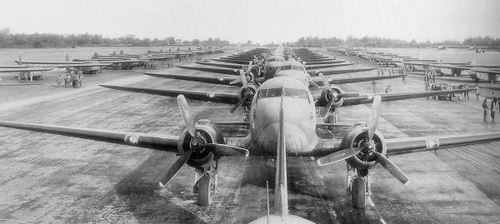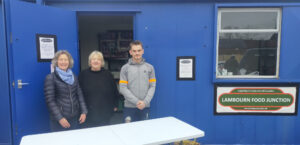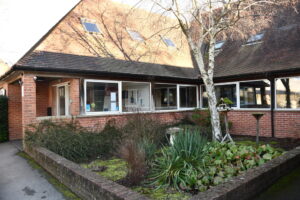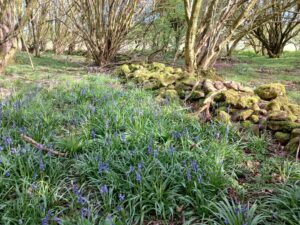
RAF MEMBURY – USAAF STATION 466
Liz Beard who supplied this information based on text from the late John Pottinger of Lambourn.
C-47 tow planes lined up at Membury

Its construction was authorised in May 1941 as a training airfield for 91 Group, Royal Air Force Bomber Command. By the beginning of August 1942 and with many of its building incomplete: RAF technicians arrived to install equipment and – withdraw smartly a few days later as RAF Membury was allocated to the VIIIth United States Army Air Force on the 10th.
Designated USAAF Station 466; the first headquarters personnel arrived at Lambourn Great Western Railway Station and were taken in buses to their airfield quarters on the 21st. The first aircraft to arrive in significant numbers were the C47 Skytrain (DC3 Dakota) of the 64th Troop Carrier Group. Soon to be followed by the F9 Fortresses and F4 Lightenings of the 3rd Photo Group. All were assigned to the XIIth USAAF for Operation “Torch”; the invasion of the North-West coast of Africa in preparations for the attack on Axis forces in Tripolitania.
So it was not until mid-November that any kind of routine could be said to exist for the newly arrived personnel of the 67th Observation Group, as a trickle of former RAF Spitfires MK Va and Douglas Boston Aircraft arrived to supplement their L-4 Piper Cubs. By August 1943, they had participated in the large, joint, Anglo-Canadian-US Exercise “Spartan”, flown Spitfires in sweeps along the French Channel Coastline in company with the FAF and, sustained their first active service fatalities when two Boston’s were lost in similar operations. Though barely familiar with the Mustang aircraft which were now gradually replacing their Spitfires they were selected to host and train the newly arrived and formed IXth USAAF, 354th Fighter Group. Including “aces” from their war against Japan, these soon moved on the Greenham Common as their Rolls-Royce ‘Merlin’ powered P51B Mustangs arrived in early November. On the 13th, the airfield was transferred to the USSAF IXth AF and by the end of December, the last of the 67th‘s squadrons had followed the other onto Salisbury Plain.
Passed back to the RAF for alterations to meet the needs its new owners, including the extension of its North/South runway close to Ermin Street. This work did not however prevent the 366th Fighter Group and their large Thunderbolt fighter aircraft taking up residence for a couple of month until their departure for Thruxton on March the 1st 1944.
On the 3rd, the 436th Troop Carrier Group and its C47 equipped four squadrons arrived and began training with the paratroopers and airborne soldiers of the locally based 501st Battalion of the American 82nd Airborne Division. Their first combined active service mission was called “Albany” – the ‘D’ Day airlift which started late on the evening of June 5th, with the laden C47’s towing, Hadrian and Horsa glider to Normandy. The following evening, operation “Elmira” required them to transport a supporting Field Artillery Battalion for an after-dark drop. On D+1 the following day, the 442nd Troop Carrier Group staged through Membury to take part in re-supply of the US 101st Airborne Division. Following these early large-scale operations, many smaller re-supply missions were flown and part of the group was detached to participate in Operations “Anvil/Dragoon”‘ the dropping of paratroops and glider-borne troops behind the assault beaches in Italy, on August 15th.
Re-assembled at Membury by late August in readiness for Operations “Market Garden” they flew the 506th Parachute Infantry Regiment to the Eindhoven sector to capture and secure the vital Wilhemena Canal crossing on September 17th. On ‘D’+ 6 they towed gliders to re-supply of the 82nd Airborne near Nijmegen during their final “Garden” mission. Turning immediately to training for the Rhine crossings they also continued with routine cargo transport duties up until their departure for France in February 1945.
Handed back to the RAF, Membury was virtually dormant until the arrival in July of 525 Squadron of Transport Command and their Dakota Aircraft. Supplemented by 187 Squadron in September, moving troops to India and the Middle-East started in October and carried on for about a year. Both squadrons left by November and by April 1947, Membury was no longer active.
Whilst no longer operational for military purposes there are still many original features in evidence today. The four aircraft hangers are still standing, having been converted to industrial units. Pieces of the runways are also still in evidence as are some of the administrative buildings which were built in the heyday of the airfield.
More recently Membury Airfield is one of the main locations used in the filming or the BBC Dr Who chase sequence in “Planet of the Spiders”. It’s here that the Doctor takes off in an autogyro. It was also used in “The Daemons” for the scene in Bessie’s garage.
John Pottinger




